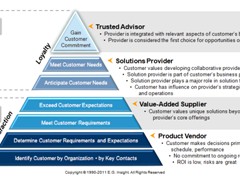Our Beliefs
Click on an item below to expand selection
Some of your customers are more critical to your business than others. It’s not unkind – it’s true. In many businesses, 80% of the business is generated by 20% of the customers. The Pareto Principle rules.
How do you handle the critical 20% who comprise your key customers? What strategies are in place for: a) keeping – even expanding – their businesses; and, b) understanding what their businesses will need in the future?
If you want to gain deeper insight into what the key decision makers from your most valuable customers are thinking, you need to gather data from a group that is intentionally selected – not a random sample. And, as long as you’re collecting feedback, why not build trust in the process via a face-to-face structured conversation about their needs?
See blog post: “Gathering B2B Customer Feedback: Three Rules to Break”
When getting feedback from customers, the method you choose speaks more loudly than the words you use. The method is the message.
When using an anonymous e-mail survey, your most critical customers’ feedback is treated the same as everyone else’s. Is that really your intent? A face-to-face, structured conversation with your customer shows that you are interested in their specific feedback and that you also desire to strengthen your business relationship.
Select a method of listening that matches the message you want to send and the kind of relationship you want to cultivate. If you want to build closer relationships with your key customers, consider adding face-to-face interviews to your feedback mix.
See blog post: “The Method is the Message”
If you don’t have a structured process to capture face-to-face feedback from your most important customers, what are you missing? Face-to-face conversations are your opportunity to:
- Go deeper. Online surveys have their place – they get to the what. How can you get to the why?
- Build relationships. Taking the time to discuss past performance and future needs is critical in building better long-term partnerships.
- Increase customer confidence. Being open and honest about your successes, misses, and plans to improve will put you ahead of the competition.
In a Facebook and Twitter world, any significant long-term relationship is still founded on face-to-face interactions.
See blog post: “Three Reasons to Add Face-to-Face Reviews to Your Customer Feedback Efforts“
The Customer Relationship Hierarchy (pictured below) was foundational to our company’s beginnings 20 years ago. At that time, it was a revelation that our customers experience us differently – as a product vendor, value-added supplier, solution provider, or trusted advisor – depending upon how we meet their requirements, expectations, and needs. Today, it is common sense, but even more critical to determine:
- How do your most valuable customers perceive you?
- Where would they place you on the Customer Relationship Hierarchy today?
- Where do they want you to be on the hierarchy tomorrow?
- What will it take for you to get there?
See blog post: “Do Your Customers Think of You as a Trusted Advisor?”
One of the keys to innovation is listening closely to customers and connecting the dots. How can you get an understanding of market changes and be the first to capitalize on cutting-edge opportunities?
- Ask the right questions.
- Talk to customers and prospects.
- Ask in the right way.
- Understand that all feedback is not created equally.
Seeing around the next corner can be tricky. Leverage your customer relationships by obtaining critical feedback to drive toward unexpected and profitable innovation.
See blog post: “Listening with an Ear for Innovation“
Your employees have more to do with your success than your products, your services, your strategies, or your customers. At every step – planning, designing, delivering – you depend upon capable, committed employees to get the job done and to do it in a way that reflects your organization’s values.
Understanding the concerns, ideas, satisfaction, and mind-set of employees helps you to manage the most valuable part of your business. Gathering and analyzing employee feedback to use in your strategic planning is not a nice-to-have; it’s a need-to-have. It all begins and ends with talent – and you should know what yours is thinking.
Learn how we can help you improve relationships with your employees >>

